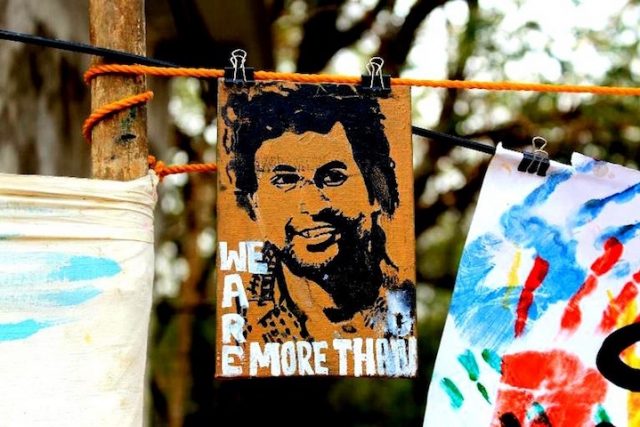Rohit Vemula’s institutionalized murder and the repercussions it made own a specific position in the post-Mandal era. Ever since the secular institution(s) killed Vemula, his name itself has become an inevitable memory of the Dalit-Muslim-Adivasi student communities on Indian campuses. Even after the Mandal, the perception of academic spaces was not completely separated from the idea of Agraharas. The student environment was totally ignorant of the uneven distribution of capital. The ignorant administration and casteist student environment combined to form the process of institutional murder of students. Vemula’s death was exposing ignorance. It was a rude awakening to society which never cared about the institutional murders of marginalized students before him. The crux of the Rohit movement was that the sheer concern was not letting the Brahmanic institution(s) produce one more Vemula and not allowing society to see the making of Vemulas.
In Indian educational institutions, caste primarily works as a prejudice in a student’s life. This determines a student’s access to each door. The prejudice is a projectile of the Brahmanical karma world order. And the karma order itself is a predetermined present, whose formative agent is not causation but the pre-birth sin. Karma is hence canceling the whole idea of ‘present’. Here dictation replaces independence. Vemula was a representation of a canceled present as such. Vemula’s being was determined by the karma order. His present was fixed. To rise above the dictation of karma order, he was compelled to end his life, so as to escape real-time and its constraints. Arun Asokan, a scholar from HCU has discussed the impossibilities put forward by karma order for liberation becoming. Vemula along with some of his colleagues were suspended and banned from availing certain facilities of the campus following the series of letters sent from the ministry of human resources HCU authorities. Vemula’s institutional murder was, in fact, not an incidental thing rather it had actually begun with social banishments of this sort. Vemula was forced to move from banishment (in living time) to liberation (death) so as to escape his ‘being’ and attain the ‘becoming’ (aspired reality).
Since the path to aspired reality was death, it was simultaneously unattainable in reality. Rohit’s institutional murder hence also explains how the environment spared no scope for hope in his lived time. From social banishments to Velivada, Rohit was himself reflecting how caste was working in the state’s secular construct(ion)s. The protest and the Bahujan resistance which was associated with the living person was transforming itself into a spreading spirit after the forced suicide of Vemula. It can also be observed in his note, where he wrote he could travel to the stars and other planets. This dream can also be read as registering life as a protest in timelessness, thereby breaking the ideology of karma which was his birth, about which he denotes in the same letter as his ‘fatal accident’.
By the very moment, Rohit was institutionally murdered, he was reborn to many Rohits. The post-Vemula period was characterized by self-assertive movements of Dalit-Adivasi-Muslim solidarities, with a conscious detachment from the binary of ‘oppressive right’ and ‘progressive left’. They came up with their own vocabularies and collective culture by dethroning the protest grammar of the so-called ‘agents’. But why did the Dalit-Muslim-Adivasi student communities have to give up their hope on the progressive secular left? We can find the answer in Vemula. Vemula himself was a product of the failure of the progressive left. The authority over the subaltern discourse was made accessible to the upper castes through the left organizations. The Brahmins led the discussions and resistance march against the same narratives which placed them at the top of the social hierarchy. The resistance was hence reduced to mere performative actions which brought validations for the parties instead of structural changes. This crucial detachment from the Brahmanical left is where we can see the inevitable presence of Vemula as a consciousness in the Dalit-Bahujan movements.
Now that the detachment is confirmed and evident as we see a constant presence of Vemula in the Dalit-Bahujan student struggles, it speaks by itself that Vemula is not a mere name to be commemorated on some specific date the struggle is rather to not confine Vemula’s memory to any specific isolated time period. The left, whose failure was the major constituent in the making of Vemula, is also appropriating the Rohit movement. If it’s a mere commemoration of some specific date or time and not thinking about the sustenance of the movement, such kind of resisting cannot bring any outcome.
The Rohit movement was a result of the failure of the system. How to not see more Vemulas is a question whose answer could be hardly discovered when thinking within the scope of the system. Since the system is naturally discriminative, the marginalized sections are the malfunction of the system. This is why Radhika Vemula also was stressing the need to acquire power for the SC/ST communities. The Rohit question always puts more questions. Rohit’s question is also the question of all the Dalit-Muslim-Adivasi students who are (being) institutionally murdered.






